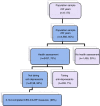Oscillometric measure of blood pressure detects association between orthostatic hypotension and depression in population based study of older adults
- PMID: 24138959
- PMCID: PMC3816594
- DOI: 10.1186/1471-244X-13-266
Oscillometric measure of blood pressure detects association between orthostatic hypotension and depression in population based study of older adults
Abstract
Background: White matter hyperintensities may contribute to depression by disrupting neural connections among brain regions that regulate mood. Orthostatic hypotension (OH) may be a risk factor for white matter hyperintensities and accumulating evidence, although limited suggests it may play a role in the development of late-life depression. The aim of this study was to examine the relationship between an oscillometric measure of orthostatic hypotension and depression in population based sample of older adults.
Methods: We analysed data on adults aged 60 and over from the first wave of The Irish Longitudinal Study on Ageing (TILDA). Depression was assessed using the Center for Epidemiologic Studies--Depression (CES-D) scale and OH was assessed by a sit-to-stand orthostatic stress test; two seated blood pressure measurements were followed by a single standing blood pressure measurement. Participants self reported whether they felt dizzy, light-headed or unsteady on standing.
Results: Participants with symptomatic OH (SOH, n=20) had the highest mean CES-D score (mean 8.6, SE 1.6) when compared to participants with asymptomatic OH (AOH) (mean 5.6, SE .48) and participants with no OH (mean 5.2, SE .14) and this difference was significant for both comparisons (p<0.001). Linear regression analysis adjusted for socio-demographic and clinical characteristics showed that SOH was associated with higher CES-D scores (unstandardised B coefficient = 2.24; 95% CI .301 - 4.79; p =0.05) compared to participants without OH. AOH was not associated with higher CES-D scores (unstandardised B coefficient =.162; 95% CI -.681, 1.00; p= 0.70).
Conclusions: Symptomatic orthostatic hypotension is associated with depression in older adults and needs to be considered in studies examining the relationship between vascular disease and depression in older adults.
Figures
Similar articles
-
Longitudinal Association Between Orthostatic Hypotension at 30 Seconds Post-Standing and Late-Life Depression.Hypertension. 2018 May;71(5):946-954. doi: 10.1161/HYPERTENSIONAHA.117.10542. Hypertension. 2018. PMID: 29632103
-
Orthostatic hypotension, orthostatic intolerance and frailty: The Irish Longitudinal Study on Aging-TILDA.Arch Gerontol Geriatr. 2015 May-Jun;60(3):507-13. doi: 10.1016/j.archger.2015.01.008. Epub 2015 Jan 17. Arch Gerontol Geriatr. 2015. PMID: 25687529
-
Is orthostatic hypotension and co-existing supine and seated hypertension associated with future falls in community-dwelling older adults? Results from The Irish Longitudinal Study on Ageing (TILDA).PLoS One. 2021 May 27;16(5):e0252212. doi: 10.1371/journal.pone.0252212. eCollection 2021. PLoS One. 2021. PMID: 34043698 Free PMC article.
-
Orthostatic hypotension and symptomatic subclinical orthostatic hypotension increase risk of cognitive impairment: an integrated evidence review and analysis of a large older adult hypertensive cohort.Eur Heart J. 2018 Sep 1;39(33):3135-3143. doi: 10.1093/eurheartj/ehy418. Eur Heart J. 2018. PMID: 30052878 Free PMC article.
-
Orthostatic Hypotension and Falls in Older Adults: A Systematic Review and Meta-analysis.J Am Med Dir Assoc. 2019 May;20(5):589-597.e5. doi: 10.1016/j.jamda.2018.11.003. Epub 2018 Dec 21. J Am Med Dir Assoc. 2019. PMID: 30583909
Cited by
-
Is there an association between orthostatic hypotension and cerebral white matter hyperintensities in older people? The Irish longitudinal study on ageing.JRSM Cardiovasc Dis. 2020 Sep 3;9:2048004020954628. doi: 10.1177/2048004020954628. eCollection 2020 Jan-Dec. JRSM Cardiovasc Dis. 2020. PMID: 32953093 Free PMC article.
-
Efficacy of atomoxetine versus midodrine for neurogenic orthostatic hypotension.Ann Clin Transl Neurol. 2020 Jan;7(1):112-120. doi: 10.1002/acn3.50968. Epub 2019 Dec 19. Ann Clin Transl Neurol. 2020. PMID: 31856425 Free PMC article. Clinical Trial.
-
Orthostatic intolerance: a frailty marker for older adults.Eur Geriatr Med. 2022 Jun;13(3):675-684. doi: 10.1007/s41999-022-00618-4. Epub 2022 Feb 11. Eur Geriatr Med. 2022. PMID: 35147907
-
Cardiovascular Autonomic Dysfunction in Patients with Drug-Induced Parkinsonism.J Clin Neurol. 2017 Jan;13(1):15-20. doi: 10.3988/jcn.2017.13.1.15. Epub 2016 Oct 7. J Clin Neurol. 2017. PMID: 27730767 Free PMC article.
-
The association between orthostatic hypertension and all-cause mortality in hospitalized elderly persons.J Geriatr Cardiol. 2016 Mar;13(3):239-43. doi: 10.11909/j.issn.1671-5411.2016.03.004. J Geriatr Cardiol. 2016. PMID: 27103919 Free PMC article.
References
-
- Krishnan KR, Hays JC, Blazer DG. MRI-defined vascular depression. Am J Psych. 1997;154(4):497–501. - PubMed
Publication types
MeSH terms
LinkOut - more resources
Full Text Sources
Other Literature Sources




